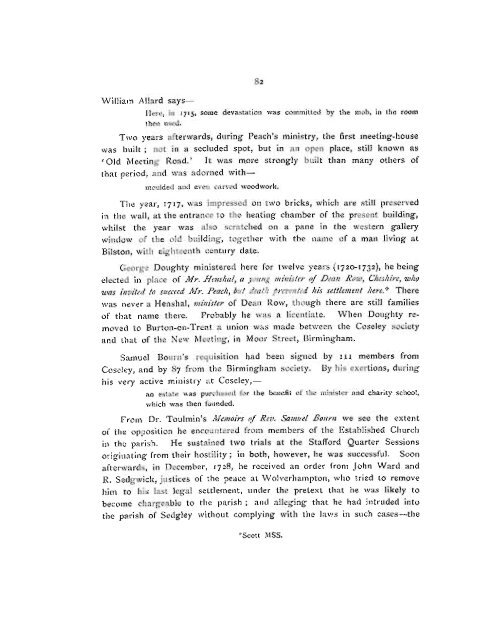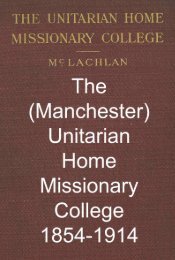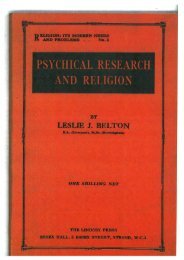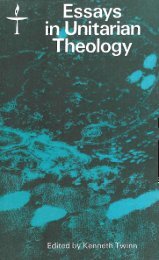Midland Churches: A History of the Congregations on - General ...
Midland Churches: A History of the Congregations on - General ...
Midland Churches: A History of the Congregations on - General ...
You also want an ePaper? Increase the reach of your titles
YUMPU automatically turns print PDFs into web optimized ePapers that Google loves.
William Allard says-<br />
Here, in 1715, some devastati<strong>on</strong> was committed by <str<strong>on</strong>g>the</str<strong>on</strong>g> mob, in <str<strong>on</strong>g>the</str<strong>on</strong>g> room<br />
<str<strong>on</strong>g>the</str<strong>on</strong>g>n used.<br />
Two years afterwards, during Peach's ministry, <str<strong>on</strong>g>the</str<strong>on</strong>g> first meeting-house<br />
was built ; not in a secluded spot, but in an open place, still known as<br />
'Old Meeting Road.' It was more str<strong>on</strong>gly built than many o<str<strong>on</strong>g>the</str<strong>on</strong>g>rs <str<strong>on</strong>g>of</str<strong>on</strong>g><br />
that period, and was adorned with-<br />
moulded and even carved woodwork.<br />
The year, 1717, was impressed <strong>on</strong> two bricks, which are still preserved<br />
in <str<strong>on</strong>g>the</str<strong>on</strong>g> wall, at <str<strong>on</strong>g>the</str<strong>on</strong>g> entrance to <str<strong>on</strong>g>the</str<strong>on</strong>g> heating chamber <str<strong>on</strong>g>of</str<strong>on</strong>g> <str<strong>on</strong>g>the</str<strong>on</strong>g> present building,<br />
whilst <str<strong>on</strong>g>the</str<strong>on</strong>g> year was also scratched <strong>on</strong> a pane in <str<strong>on</strong>g>the</str<strong>on</strong>g> western gallery<br />
window <str<strong>on</strong>g>of</str<strong>on</strong>g> <str<strong>on</strong>g>the</str<strong>on</strong>g> old building, toge<str<strong>on</strong>g>the</str<strong>on</strong>g>r with <str<strong>on</strong>g>the</str<strong>on</strong>g> name <str<strong>on</strong>g>of</str<strong>on</strong>g> a man living at<br />
Bilst<strong>on</strong>, with eighteenth century date.<br />
George Doughty ministered here for twelve years (1720-1732), he being<br />
elected in place <str<strong>on</strong>g>of</str<strong>on</strong>g> Mr. Ne7zshuZ, a y021ng 1ni7zister <str<strong>on</strong>g>of</str<strong>on</strong>g> Deaa Row, Cheshire, who<br />
was inyited to succeed Mr. Peach, but denfh jprezjel~ted his settlenteut here.++ There<br />
was never a Henshal, 71iinister <str<strong>on</strong>g>of</str<strong>on</strong>g> Dean Row, though <str<strong>on</strong>g>the</str<strong>on</strong>g>re are still families<br />
<str<strong>on</strong>g>of</str<strong>on</strong>g> that name <str<strong>on</strong>g>the</str<strong>on</strong>g>re. Probably he was a licentiate. When Doughty removed<br />
to Burt<strong>on</strong>-<strong>on</strong>-Trent a uni<strong>on</strong> was made between <str<strong>on</strong>g>the</str<strong>on</strong>g> Coseley society<br />
and that <str<strong>on</strong>g>of</str<strong>on</strong>g> <str<strong>on</strong>g>the</str<strong>on</strong>g> Nei~ Meeting,' in RfIoor Street, Birmingham.<br />
Samuel Bourn's requisiti<strong>on</strong> had been signed by 111 members from<br />
Coseiey, and by 87 from <str<strong>on</strong>g>the</str<strong>on</strong>g> Birmingham society. By his exerti<strong>on</strong>s, during<br />
his very active ministry at Coseley,-<br />
an estate was purchased for <str<strong>on</strong>g>the</str<strong>on</strong>g> benefit <str<strong>on</strong>g>of</str<strong>on</strong>g> <str<strong>on</strong>g>the</str<strong>on</strong>g> minister and charity school,<br />
which was <str<strong>on</strong>g>the</str<strong>on</strong>g>n founded.<br />
From Dr. Toulmin's Mertioirs <str<strong>on</strong>g>of</str<strong>on</strong>g> Rev. Sa7t~uel Bo~riz we see <str<strong>on</strong>g>the</str<strong>on</strong>g> extent<br />
<str<strong>on</strong>g>of</str<strong>on</strong>g> <str<strong>on</strong>g>the</str<strong>on</strong>g> oppositi<strong>on</strong> he encountered from members <str<strong>on</strong>g>of</str<strong>on</strong>g> <str<strong>on</strong>g>the</str<strong>on</strong>g> Established Church<br />
in <str<strong>on</strong>g>the</str<strong>on</strong>g> parish. He sustained two trials at <str<strong>on</strong>g>the</str<strong>on</strong>g> Stafford Quarter Sessi<strong>on</strong>s<br />
originating from <str<strong>on</strong>g>the</str<strong>on</strong>g>ir hostility ; in both, however, he was successful. So<strong>on</strong><br />
afterwards, in December, 1728, he received an order from John Ward and<br />
R. Sedgwick, justices <str<strong>on</strong>g>of</str<strong>on</strong>g> <str<strong>on</strong>g>the</str<strong>on</strong>g> peace at Wolverhampt<strong>on</strong>, who tried to remove<br />
him to his last legal settlement, under <str<strong>on</strong>g>the</str<strong>on</strong>g> pretext that he was likely to<br />
become chargeable to <str<strong>on</strong>g>the</str<strong>on</strong>g> parish ; and alleging that he had icti-uded into<br />
<str<strong>on</strong>g>the</str<strong>on</strong>g> parish <str<strong>on</strong>g>of</str<strong>on</strong>g> Sedgley without complying with <str<strong>on</strong>g>the</str<strong>on</strong>g> laws in such cases-<str<strong>on</strong>g>the</str<strong>on</strong>g><br />
"Scott MSS.<br />
place <str<strong>on</strong>g>of</str<strong>on</strong>g> his last settlement being Adlingt<strong>on</strong>, in <str<strong>on</strong>g>the</str<strong>on</strong>g> parish <str<strong>on</strong>g>of</str<strong>on</strong>g> Standish,<br />
in <str<strong>on</strong>g>the</str<strong>on</strong>g> county Palatine <str<strong>on</strong>g>of</str<strong>on</strong>g> Lancaster-and requiring him to depart, with<br />
his wife and family, before <str<strong>on</strong>g>the</str<strong>on</strong>g> 4th <str<strong>on</strong>g>of</str<strong>on</strong>g> <str<strong>on</strong>g>the</str<strong>on</strong>g> followiilg m<strong>on</strong>th, or o<str<strong>on</strong>g>the</str<strong>on</strong>g>rwise<br />
bring a certificate, showing that he was a parishi<strong>on</strong>er. These proceedings<br />
called forth a dignified and indignant protest from him, and in a letter,<br />
dated 27 December, 1728, he says :-<br />
I caliile i~zto tAe parish apo7z <str<strong>on</strong>g>the</str<strong>on</strong>g> z/nani?jzozrs ifzvitnti<strong>on</strong> <str<strong>on</strong>g>of</str<strong>on</strong>g> a nu~?zerous<br />
co~zg~egnti<strong>on</strong> <str<strong>on</strong>g>of</str<strong>on</strong>g> Proteskant dissenters, which i/zz~jit~i207~ - zuas slgaed by<br />
abozle a hu?zdred pers<strong>on</strong>s, many <str<strong>on</strong>g>of</str<strong>on</strong>g> <str<strong>on</strong>g>the</str<strong>on</strong>g>m szrbstatitial yeouzen, farnzers,<br />
and trades~nen, and i~zost <str<strong>on</strong>g>of</str<strong>on</strong>g> <str<strong>on</strong>g>the</str<strong>on</strong>g>~~z inhnbil'ants <str<strong>on</strong>g>of</str<strong>on</strong>g> <str<strong>on</strong>g>the</str<strong>on</strong>g> parish, mzd as this<br />
is agreeable to tAe niost pri~)zitlire =lay <str<strong>on</strong>g>of</str<strong>on</strong>g> nlinisters a7zd bishops <str<strong>on</strong>g>of</str<strong>on</strong>g><br />
settling with a pecjle, so I take it to be as h<strong>on</strong>oz./rable a way as any<br />
t/y athich any clergynian in <str<strong>on</strong>g>the</str<strong>on</strong>g> courzty came into hZj present settlemelzt.<br />
Bourn forwarded a certificate which satisfied <str<strong>on</strong>g>the</str<strong>on</strong>g> magistrates as to his<br />
legal right to dwell in <str<strong>on</strong>g>the</str<strong>on</strong>g> parish. Many friends in Birmingham sympathised<br />
with him in <str<strong>on</strong>g>the</str<strong>on</strong>g> persecuti<strong>on</strong>s to which he had been subjected, and raised a<br />
subscripti<strong>on</strong> to defray <str<strong>on</strong>g>the</str<strong>on</strong>g> expenses which he had incurred in <str<strong>on</strong>g>the</str<strong>on</strong>g> various<br />
trials. \<br />
He c<strong>on</strong>tinued to labour actively for <str<strong>on</strong>g>the</str<strong>on</strong>g> religious welfare <str<strong>on</strong>g>of</str<strong>on</strong>g> his c<strong>on</strong>gre-<br />
gati<strong>on</strong>s until Sunday, 17 March, 1754, when he was suddenly stricken with<br />
paralysis whilst in <str<strong>on</strong>g>the</str<strong>on</strong>g> pulpit at Coseley, and died <strong>on</strong> <str<strong>on</strong>g>the</str<strong>on</strong>g> following Friday.<br />
William Edwards, who became minister here in 1761, at <str<strong>on</strong>g>the</str<strong>on</strong>g> termina-.<br />
ti<strong>on</strong> <str<strong>on</strong>g>of</str<strong>on</strong>g> <str<strong>on</strong>g>the</str<strong>on</strong>g> c<strong>on</strong>necti<strong>on</strong> between <str<strong>on</strong>g>the</str<strong>on</strong>g> Coseley and New Meeting societies,<br />
appears as <strong>on</strong>e <str<strong>on</strong>g>of</str<strong>on</strong>g> <str<strong>on</strong>g>the</str<strong>on</strong>g> petiti<strong>on</strong>ing ministers <str<strong>on</strong>g>of</str<strong>on</strong>g> 1772-3. Apparently <str<strong>on</strong>g>the</str<strong>on</strong>g>re<br />
was no relati<strong>on</strong>ship between him and John Edwards, Dr. Priestley's<br />
immediate successor at <str<strong>on</strong>g>the</str<strong>on</strong>g> New Meeting.<br />
Richard Amner left Coseley, about <str<strong>on</strong>g>the</str<strong>on</strong>g> end <str<strong>on</strong>g>of</str<strong>on</strong>g> 1794, and devoted him-<br />
self to study in Hincliley ; he became a c<strong>on</strong>tributor to <str<strong>on</strong>g>the</str<strong>on</strong>g> Gentlenratv's<br />
Magazine.<br />
In its early years <str<strong>on</strong>g>the</str<strong>on</strong>g> r'M<strong>on</strong>th& Mdztifrg (founded in 1782, its first regular<br />
assembling being at Coseley, <strong>on</strong> 4 June, <str<strong>on</strong>g>of</str<strong>on</strong>g> that year) exercised<br />
Presbyterial functi<strong>on</strong>s, and <strong>on</strong> 11 October, 1796, Samuel Parker was, at<br />
Coseley, ordained as a Christia;~ nzi7zister. H'. Proctor i~ztrodz~ced f& serzrice with<br />
Prayer, a7zd reading <str<strong>on</strong>g>the</str<strong>on</strong>g> .Ycr@Lzrres; Rev. Samuel Grzfiths ashed some p.r/esti<strong>on</strong>s,<br />
and prayed a genernl and O~ctin,ifl'~~z Prayer; Rev. Radclzfe Scholejeld deliztel-ed






